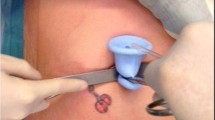Abstract
Objective
Use of the VersaStepTM trocar system (US Surgical, Norwalk, CT) has the perceived advantage of minimal trocar-related hernias in patients undergoing Roux-en-Y gastric bypass surgery (RYGB). We performed a retrospective review of our last 747 consecutive operative procedures using these trocars.
Methods and procedures
The patient population was 747 consecutive patients who underwent laparoscopic RYGB at Duke University Health System Weight Loss Surgery Center from January 2002 through April 2005. A total of 3735 radially expanded trocar sites were used. VersaStepTM trocars were used in all cases. The port configuration included one supraumbilical Hasson port, two 12-mm ports, and three 5-mm ports. The Hasson port was closed with a figure-of-eight number 1 Polysorb suture. All other trocar sites had no fascial closure. Intestinal anastomoses were created with a linear stapler in all of the laparoscopic cases, with hand suturing of the residual enterotomy. The fascial incisions were therefore not extended to accommodate an EEA stapler. The charts were reviewed for occurrence of subsequent trocar site hernias.
Results
There were no hernias at any of the VersaStepTM trocar sites—an incidence of 0%. There were nine incisional hernias at the Hasson port site which later required surgical repair—an incidence of 1.20%.
Conclusions
There were no hernias detected at any of the 1494 12-mm or 2241 5-mm VersaStepTM trocar sites, despite lack of suture closure. At the Hasson port site, there was a hernia incidence of 1.20%. In the bariatric RYGB population, routine suture closure of the fascia or muscle is not necessary when using radially expanding VersaStepTM trocars.
Similar content being viewed by others
References
Bowrey DJ, Blom D, Crookes PF, Bremmer CG, Johansson M, Lord RV, Hagen JA, DeMeester SR, DeMeester TR, Peters JH (2001) Risk factors and the prevalence of trocar site herniation after laparoscopic fundoplication. Surg Endosc 15: 663–666
Bhoyrul S, Mori T, Way LW (1996) Radially expanding dilation: a superior method of laparoscopic trocar access. Surg Endosc 10: 775–778
Bhoyrul S, Payne J, Steffes B, Swanstrom L, Way LW (2000) A randomized prospective study of radially expanding trocars in laparoscopic surgery. J Gastrointest Surg 4: 392–397
Demaria EJ, Surgerman HJ, Kellum JM, Meador JG, Wolfe LG (2002) Results of connsecutive total laparoscopic Roux-en-Y gastric bypasses to treat morbid obesity. Ann Surg 235:640–647
Horgan PG, O’Connell P (1993) Subumbilical hernia following laparoscopic cholecystectomy. Br J Surg 80: 1595
Jones DB, Provost DA, DeMaria EJ, Smith CD, Morgenstern L, Schirmer B. (2004) Optimal management of the morbidly obese patient: SAGES appropriateness conference statement. Surg Endosc 18: 1029–1037
Lam TY, Lee SW, So HS, Kwok SP (2000) Radially expanding trocar: a less painful alternative for laparoscopic surgery. J Laparoendosc Adv Surg Tech 10: 269–273
Marema RT, Perez M, Buffington CK (2005) Comparison of the benefits and complications between laparoscopic and open Roux-en-Y gastric bypass surgeries. Surg Endosc 19: 525–530
Mayol J, Garcia-Aguilar J, Otiz-Oshiro E, De-Diego Carmona J, Fernanadez-Represa J (1997) Risks of minimal access approach for laparoscopic surgery: mulitvariate analysis of morbidity related to umbilical trocar insertion. World J Surg 21: 529–533
Montz FJ (1994) Incisional hernia following laparoscopy: a survey of the American Association of Gynecologic Laparoscopists. Obstet Gynecol 84: 881
National Institutes of Health (1992) Gastrointestinal surgery for severe obesity: National Institutes of Health Consensus Development Conference statement. Am J Surg 55: 615S–619S
Nguyen NT, Goldman C, Rosenquist CJ, Arango A, Cole CJ, Lee SJ, Wolfe BM (2001) Laparoscopic versus open gastric bypass: a randomized study of outcomes, quality of life, and costs. Ann Surg 234: 279–289
Oria HE, Moorehead MK (1998) Bariatric surgery analysis and reporting outcome system. Obesity Surg 8: 487–499
Pories WJ, Swanson MS, MacDonald KG, Long SB, Morris PG, Brown BM, Barakat HA, deRamon RA, Israel G, Dolezal JM, Dohm L (1995) Who would have thought it? An operation proves to be the most effective therapy for adult onset diabetes mellitus. Ann Surg 222: 339–350
Pi-Sunyer FX, the International Obesity Task Force (1998) Clinical guidelines on the identification, evaluation, and treatment of overweight and obesity in adults—the evidence report. National Institutes of Health. Obesity Res 6 (Suppl 2): 51S–209S
Sans-Lopez R, Martinex-Ramos C, Nunez-Pena JR, Ruiz de Gopegui M, Pastor-Sirera L, Tamames-Escobar S. (1999) Incisional hernias after laparoscopic vs open cholecystectomy. Surg Endosc 13: 922–924
Storms P, Stuyven G, Vanhemelen G, Sebrechts R (1994) Incarcerated trocar wound hernia after laparoscopic hysterectomy: Is closure of large trocar fascia defects after laparoscopy necessary? Surg Endosc 8: 901–902
Surgerman HJ, Kellum JM, Engle KM, Wolfe L, Starkey JV, Birkenhauer R, Fletcher P, Sawyer MJ (1992) Gastric bypass for treating severe obesity. Am J Clin Nutr 55 (Suppl 2): 560S–566S
Surgerman HJ, Kellum JM, Jr, Reines HD, DeMaria EJ, Newsome HH, Lowry JW (1996) Greater risk of incisional hernia with morbidly obese than steroid dependent patients and low recurrence with prefascial polypropylene mesh. Am J Surg 171: 80–84
Tonouchi H, Ohmori Y, Kobayashi M, Kusunoki M. (2004). Trocar site hernia. Arch Surg 139: 1248–1256
Yim SF, Yuen PM (2001) Randomized double-masked comparison of radially expanding access device and conventional cutting tip trocar in laparoscopy. Obstet Gynecol 97:435–438
Author information
Authors and Affiliations
Corresponding author
Rights and permissions
About this article
Cite this article
Johnson, W.H., Fecher, A.M., McMahon, R.L. et al. VersaStepTM trocar hernia rate in unclosed fascial defects in bariatric patients. Surg Endosc 20, 1584–1586 (2006). https://doi.org/10.1007/s00464-005-0747-8
Received:
Accepted:
Published:
Issue Date:
DOI: https://doi.org/10.1007/s00464-005-0747-8




